“The company is 115 years old and sometimes you literally feel the weight, the call, and the challenge of those who ran the company before us,” says Giovanni Bianchi, grandson to Pio Tosini, who currently runs the family business along with his cousin, also grandson to Pio, Nicola Tosini.
Recently, Giovanni and I conducted an internet interview–I in my home in Portland, Maine and he from the small town of Langiharno in Emilia Romagna, Italy, home to Pio Tosini since the beginning.
Although there is a rich family tradition of passing the Pio Tosini torch, Giovanni says, “Our parents never forced us to follow their steps.” In fact Giovanni and Nicola did not initially pursue the family business; rather, they studied Law and Economics, respectively. “[But] we always thought of our family business as a big opportunity and a great challenge,” Giovanni says.
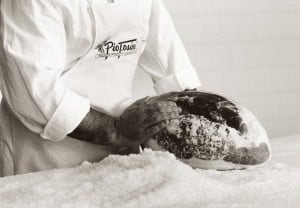 So the cousins answered “the call” to become the fourth generation to run the family business of Pio Tosini–a successful, well-run business with such integrity and commitment to tradition–dare I say it–it could be called legendary.
So the cousins answered “the call” to become the fourth generation to run the family business of Pio Tosini–a successful, well-run business with such integrity and commitment to tradition–dare I say it–it could be called legendary.
What is the secret recipe for a legendary business? To me, it became clear as Giovanni and I volleyed emails, it looks like a delightfully curious amalgam of paradoxes: tradition and modernity; simplicity and complexity; ease and persistence.
Also, a good logo. Yes, a really good logo definitely doesn’t hurt. More on that later as I explore a beautiful, heartfelt ode to logos–specifically the Pio Tosini logo–written by Ari Weinzweig of Zingerman’s.
But first, what of that blend of tradition and modernity? What’s the history of Pio Tosini? It began well over a century ago, in that same small town of Langhirano where Giovanni still lives and runs the daily operations of the company to this day. Pio’s grandfather, Ferrante Tosini, slaughtered his own pigs and cured the meat in the back room of the family’s grocery store. From there, Ferrante and young Pio began experimenting with new processing techniques and curing methods, gradually improving the business. That experimenting continued over the generations–melding the new with the old–to land in the hands, today, of Giovanni and Nicola.
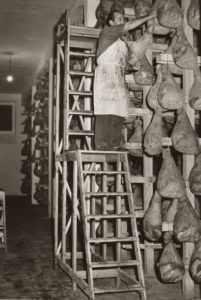 I asked Giovanni what roles he and Nicola play in their family company. Although Nicola heads production and selection while Giovanni is in charge of food safety policies and accreditation, Giovanni says, “Being a small family run business, we are pretty much interchangeable.” So, even though there are modern regulations, policies and procedures in place, in some ways–in most ways, really– the family’s way of producing and curing meat hasn’t changed that much since it all started.
I asked Giovanni what roles he and Nicola play in their family company. Although Nicola heads production and selection while Giovanni is in charge of food safety policies and accreditation, Giovanni says, “Being a small family run business, we are pretty much interchangeable.” So, even though there are modern regulations, policies and procedures in place, in some ways–in most ways, really– the family’s way of producing and curing meat hasn’t changed that much since it all started.
And then in 2012–over a century after its inception– Pio Tosini Prosciutto ranked among the top 10 best Proscuitto di Parma by Slow Food Italy.
So what about the proscuitto? What makes it one of the top 10? This is where the paradox of simplicity and complexity comes in. “It’s really something that takes time and passion,” says Giovanni. These are attributes I think of as a complex—there are no simple shortcuts or quick results. However, the ingredients and steps are rather simple. Giovanni says, “It’s just pork meat and….sea salt from Sicily and from Puglia.” And because the process and product is so pure, Giovanni says, “The main ingredient selection process is crucial.”
That’s where one of the few staff members comes in. A highly trained professional called mastro salatore (“master salter”).
The mastro salatore at Pio Tosini is a man named Enore who has worked with the company for over 13 years. Enore, trained for years, selects only the best legs according to the company’s standards. Pio Tosini actually uses less salt in the curing process than many proscuitto producers which means, in order to achieve sweetness, the ham must cure for a longer period–20 months, to be exact, almost seven months longer than most other proscuitto. Time and salt–simple yet complex: with so few components, there isn’t much room for error.
I imagine after 13 years, Enore is part of the family. I am curious about this man? What else brings Enore joy?
Giovanni reveals “Enore is really into football–or shall I say soccer–” (he clarifies for the American)– “he is a talented coach of our local football team.”
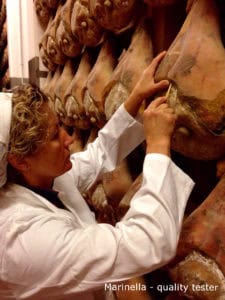 Then there is Marinella. For well over 30 years, she has been in charge of another key step in the production of Pio Tosini proscuitto: puntatura. Puntatura is the process of using a horse bone needle–called ago di osso di cavallo– to pierce each ham leg in several sections to ensure quality. This ensurement requires the use of sight, touch and smell. Because horse bone is porous, odors do not linger from one section of leg to the next, allowing Marinella to accurately detect any defects in the meat and ensure quality and sufficient aging of all parts of the leg.
Then there is Marinella. For well over 30 years, she has been in charge of another key step in the production of Pio Tosini proscuitto: puntatura. Puntatura is the process of using a horse bone needle–called ago di osso di cavallo– to pierce each ham leg in several sections to ensure quality. This ensurement requires the use of sight, touch and smell. Because horse bone is porous, odors do not linger from one section of leg to the next, allowing Marinella to accurately detect any defects in the meat and ensure quality and sufficient aging of all parts of the leg.
Giovannia explains that, “Puntatura is done generally twice–at month 12 before putting the DOP Parma Crown and again, upon selection, right before shipping.” When Marinella is not using her almost magical skills at Pio Tosini, she can be seen riding her bicycle along the country roads of the surrounding hills, coasting on the winds that sweep through the pine and chestnut forests.
But before puntatura, at about the six month mark, the legs require another important step: sugna—a rendered pork fat which is spread over the curing meat to prevent excessive surface drying. Every prosciuttificio has their own blend with various proportions; Pio Tosini’s sugna is made especially for them by a local producer and comprises pork lard, rice flour, salt and pepper.
Pio Tosini crafts both bone-in and boneless legs. “Bone-in is definitely the most impressive, spectacular and traditional style of slicing proscuitto,” Giovanni says. However, a legato boneless leg is pretty spectacular, too. Legato means “tied together,” and in reference to music, indicates “musical notes played or sung smoothly and connected.” Giovanni explains, “The Legato doesn’t have to fit in a pre-shaped mold during the deboning process so it allows for a slightly bigger size of the leg. Moreover, not being pressed, it is even more natural in texture.” I imagine the smooth, undisturbed texture of the delicate meat melting on my tongue, much like the beauty of seamless music or a song to my ears.
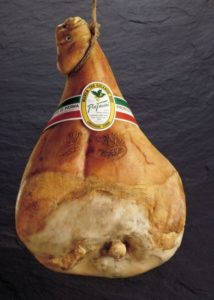 Ok so, the legs are cured–now they are ready to be wrapped and shipped, ready for the beloved logo. The Pio Tosini logo was designed by Giovanni’s grandmother, Maria Scotti, in the late 1930s. To give a quick description, the logo comprises three green oak leaves with three pale yellow and brown acorns, attached to the branch, framed by a thin brown circle with Pio Tosini written in a clear scrawl from lower left to upper right.
Ok so, the legs are cured–now they are ready to be wrapped and shipped, ready for the beloved logo. The Pio Tosini logo was designed by Giovanni’s grandmother, Maria Scotti, in the late 1930s. To give a quick description, the logo comprises three green oak leaves with three pale yellow and brown acorns, attached to the branch, framed by a thin brown circle with Pio Tosini written in a clear scrawl from lower left to upper right.
In his article, “Logos, Legends, Quotes, and Carefully Cured Ham Legs,” Ari Weinzweig of Zingerman’s Delicatessen in Ann Arbor, Michigan crafts a beautiful love letter about the Pio Tosini logo. “It’s an image that draws me in,” Ari writes. “One that ignites my imagination…it tells a tale of art, and artisans, of a couple who cared deeply for each other, of a family who care deeply about their craft.”
When Maria and Pio met, she was from a well-educated, upper middle class family in Parma and Pio was a young, middle class man from a rural mountain village. Ari writes, “Not a common connection in those days…but they left behind some of their past to create their own reality…In this case, the difference in their backgrounds–brought together by shared values, a great sense of style and, of course, strong mutual attraction–turned into something special…That shared sensibility played out beautifully, both in the graphics and the goodness of the ham.”
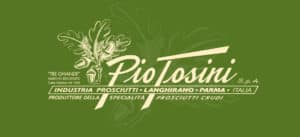 Giovanni weighs in on his favorite aspects of the logo. He says, “It’s modernity, considering that it was designed something like ninety years or so ago; objects and colors also give an idea of natural–in the sense of ‘from nature’–food.”
Giovanni weighs in on his favorite aspects of the logo. He says, “It’s modernity, considering that it was designed something like ninety years or so ago; objects and colors also give an idea of natural–in the sense of ‘from nature’–food.”
Nature. It is the common note in all that is Pio Tosini. There is no paradox there—just the purity of the natural world. “I love to spend my time in Nature,” Giovanni says, “particularly hiking, skiing and rock climbing.”
Is that all? Not quite– “Music, mainly rock ‘n’ roll is my other biggest interest, and I play guitar.”
I don’t know if rock ‘n’ roll would be considered the most seamless style of music; nonetheless, I recall legato–and I imagine the notes of Giovanni’s guitar merging with the winds of the forested hills of his hometown–where Ferrante Tosini first cured meat in the back room of the family’s grocery store–the winds that carry Marinella along on her bike and keep her company during her almost poetic process of puntatura, the winds that gently sweep through the curing house of Enore’s skillfully salted proscuitto, gently kissing each ham with its own unseeable logo, later to be joined by the visible seal of Pio Tosini designed so many years ago by Maria.
Written by Leska Tomash
PIO TOSINI PROSCIUTTO DI PARMA 20 mo. PRESSATO BONELESS